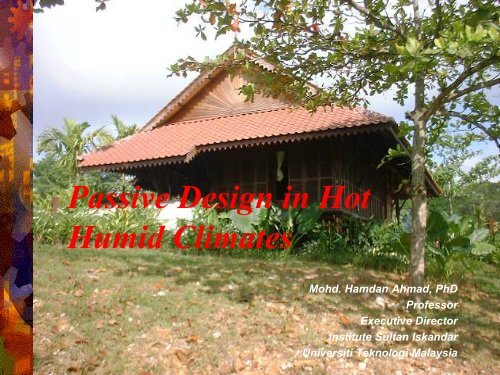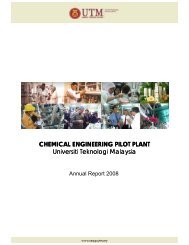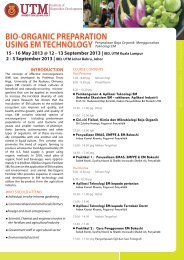Passive Design in Hot Humid Climates - IBD
Passive Design in Hot Humid Climates - IBD
Passive Design in Hot Humid Climates - IBD
You also want an ePaper? Increase the reach of your titles
YUMPU automatically turns print PDFs into web optimized ePapers that Google loves.
<strong>Passive</strong> <strong>Design</strong> <strong>in</strong> <strong>Hot</strong><br />
<strong>Humid</strong> <strong>Climates</strong><br />
Mohd. Hamdan Ahmad, PhD<br />
Professor<br />
Executive Director<br />
Institute Sultan Iskandar<br />
10/12/2011<br />
Universiti Teknologi Malaysia<br />
1
Introduction<br />
• Build<strong>in</strong>gs consumed half<br />
of the energy used daily. The<br />
energy used rise significantly<br />
due to the homogenous<br />
environment created by<br />
designers and the standardized<br />
eng<strong>in</strong>eer<strong>in</strong>g solutions. Today,<br />
most build<strong>in</strong>gs tend to waste a<br />
lot of energy by not respond<strong>in</strong>g<br />
to the climatic conditions and<br />
comfort requirement of the<br />
<strong>in</strong>habitants.<br />
•<br />
10/12/2011 2
Introduction<br />
• Application of advance<br />
technology and mechanical aids<br />
for cool<strong>in</strong>g and comfort has also<br />
play significant roles <strong>in</strong><br />
chang<strong>in</strong>g the basic design<br />
pr<strong>in</strong>ciples which we normally<br />
used to be responsive to our<br />
context – i.e. tropical climate<br />
and culture.<br />
• Thus there is a need to reevaluate<br />
and re-address the<br />
basic plann<strong>in</strong>g and design<br />
pr<strong>in</strong>ciples as designers are<br />
responsible for the energy<br />
<strong>in</strong>efficiency of the build<strong>in</strong>gs they<br />
design. They must be ecological<br />
and susta<strong>in</strong>able.<br />
10/12/2011 3
Introduction<br />
Architecture can be described from various<br />
perspectives. Historians see architecture<br />
differ than the scientist. The aristocrat and<br />
peer of the cultural realm perceived<br />
architecture more so from the cultural view<br />
po<strong>in</strong>ts. On the other hand, the<br />
environmentalists see architecture from the<br />
environmental and bio-climatic angles.<br />
Malay Architecture should not fall <strong>in</strong>to<br />
be<strong>in</strong>g a trend or fashionable item. It should<br />
be dynamic to change but keep<strong>in</strong>g what is<br />
local legible!
Susta<strong>in</strong>able Development:<br />
<br />
Susta<strong>in</strong>ability applies to actions/developments that<br />
preserve the global environment and its nonrenewable<br />
resources for present and future<br />
generations<br />
10/12/2011 5
Why Susta<strong>in</strong>able<br />
Three Basic understand<strong>in</strong>gs:<br />
<br />
<br />
<br />
That our resources are limited<br />
That our decision may not be<br />
reversible<br />
That we have moral obligation<br />
for future generation<br />
Susta<strong>in</strong>able Architecture<br />
The art or technology of mak<strong>in</strong>g build<strong>in</strong>g<br />
with human nature relationship.<br />
Objective of Susta<strong>in</strong>able<br />
Architecture:<br />
To provide comfortable & healthy<br />
environment<br />
To maximize use of natural energy forces<br />
<strong>in</strong>stead of mechanical aids<br />
To reduce energy use <strong>in</strong> build<strong>in</strong>g<br />
10/12/2011 6
<strong>Passive</strong> <strong>Design</strong><br />
• Susta<strong>in</strong>able design approach<br />
• <strong>Passive</strong> design is design that does not require mechanical<br />
heat<strong>in</strong>g or cool<strong>in</strong>g. It is about mak<strong>in</strong>g the most of local<br />
conditions to make your home comfortable, affordable and<br />
susta<strong>in</strong>able.<br />
• <strong>Passive</strong> design means design<strong>in</strong>g your home for your climate. In<br />
tropical areas, lightweight materials, shade and ventilation help<br />
keep your home cool.<br />
• MS1525:2007 Clause 4.1<br />
• <strong>Design</strong><strong>in</strong>g with<strong>in</strong> contextual climate and site are the first steps <strong>in</strong> the<br />
reduction of energy consumption, that will result <strong>in</strong> operational cost sav<strong>in</strong>gs.<br />
10/12/2011 7
MS1525:2007<br />
• MS 1525 primarily deals with build<strong>in</strong>g energy.<br />
• The steps towards Energy Efficient build<strong>in</strong>gs are:<br />
PASSIVE MEASURES<br />
ACTIVE MEASURES<br />
Clause 4:<br />
Architectural and <strong>Passive</strong> <strong>Design</strong><br />
Strategy<br />
Clause 5:<br />
Build<strong>in</strong>g Envelope<br />
+<br />
Clause 6:<br />
Light<strong>in</strong>g<br />
Clause 7:<br />
Power System and Distribution System<br />
Clause 8:<br />
Air Cond and Mech Ventilation System<br />
Clause 9:<br />
Energy Management Control System<br />
10/12/2011 8
<strong>Passive</strong> <strong>Design</strong><br />
• MS1525:2007 Clause 4 Key passive design factors<br />
4.1 Susta<strong>in</strong>able <strong>Design</strong> Approach<br />
4.2 <strong>Passive</strong> <strong>Design</strong> Strategy<br />
4.3 Site Plann<strong>in</strong>g and Orientation<br />
4.4 Daylight<strong>in</strong>g<br />
4.5 Façade <strong>Design</strong><br />
4.6 Natural Ventilation<br />
4.7 Strategic Landscap<strong>in</strong>g<br />
10/12/2011 9
<strong>Passive</strong> <strong>Design</strong><br />
• MS1525:2007 Clause 4 Key passive design factors<br />
• Key element of susta<strong>in</strong>able build<strong>in</strong>g<br />
• Aims to maximise comfort for people liv<strong>in</strong>g <strong>in</strong> a home while m<strong>in</strong>imis<strong>in</strong>g energy use and<br />
impacts on the environment<br />
• Mak<strong>in</strong>g the most of renewable, natural sources of energy, such as the sun and the<br />
w<strong>in</strong>d, to provide natural ventilation and light<strong>in</strong>g and to contribute to responsible energy<br />
waste.<br />
10/12/2011 10
Contextual Understand<strong>in</strong>g<br />
<br />
Understand<strong>in</strong>g context is vital <strong>in</strong> contextual responsive architecture.<br />
<br />
<br />
<br />
<br />
<br />
There are three major components describ<strong>in</strong>g context.<br />
The first is climate.<br />
The second is culture.<br />
The third is time (technology)<br />
Understand<strong>in</strong>g climate and culture must <strong>in</strong>clude the understand<strong>in</strong>g of<br />
the site specific; the location of the site, the climatic condition of the<br />
site, the socio-cultural issues relat<strong>in</strong>g to the site, and the users. Time<br />
relates very much to the available and appropriate technology.<br />
10/12/2011 11
Understand<strong>in</strong>g Our Tropical<br />
Climate and Thermal Comfort<br />
Criteria:<br />
• Malaysia sits between 1-8 o N<br />
latitudes, 100-119 o E<br />
longitudes.<br />
• Approximately 137km north of<br />
the Equator.<br />
10/12/2011 12
Understand<strong>in</strong>g Climate<br />
• Intense Heat/Solar radiation: 4.76 kWh/m2 (but<br />
variable with cloud<br />
cover)<br />
• High Air Temperature (<strong>in</strong>creased yearly esp.<br />
visible <strong>in</strong> m<strong>in</strong>imum air temperature) 22-34 o C<br />
• Small diurnal air temperature range: less than<br />
10<br />
• High humidity: >50% and very high at night<br />
• Generally, very light w<strong>in</strong>ds: 0.5-3 m/s (1-6 knots)<br />
• Cloudy Sky: >6 oktas, High Diffused Light<br />
Components (53%)<br />
• Ra<strong>in</strong>fall above global average (annual: 2600mm)<br />
10/12/2011 13
Climate Data<br />
World Temperature Zon<strong>in</strong>g<br />
Malaysia<br />
Source: www.myforecast.com
Climate Data<br />
Source: www.climate-charts.com (2007)
Climate Data<br />
Kuala Lumpur, Malaysia<br />
Source: www.climate-charts.com (2007)
Climate Data<br />
Temperature<br />
Kuala Lumpur, Malaysia (Jan – Sept 2011)<br />
Max Avg M<strong>in</strong> Sum<br />
Max Temperature 35 °C 32 °C 24 °C<br />
Mean Temperature 30 °C 28 °C 23 °C<br />
M<strong>in</strong> Temperature 27 °C 24 °C 22 °C<br />
Degree Days<br />
Heat<strong>in</strong>g Degree Days (base 65) 0 0 0 0<br />
Cool<strong>in</strong>g Degree Days (base 65) 22 17 9 4628<br />
Grow<strong>in</strong>g Degree Days (base 50) 36 32 24 8711<br />
Dew Po<strong>in</strong>t<br />
Dew Po<strong>in</strong>t 30 °C 24 °C 20 °C<br />
Precipitation<br />
Precipitation - - - -<br />
Snowdepth - - - -<br />
W<strong>in</strong>d<br />
W<strong>in</strong>d 37 km/h 6 km/h 0 km/h<br />
Gust W<strong>in</strong>d 47 km/h 34 km/h 23 km/h<br />
Sea Level Pressure<br />
Sea Level Pressure 1014 hPa 1009 hPa 1002 hPa<br />
Source: www.wunderground.com
Climate Data<br />
Kuala Lumpur, Malaysia (Jan – Sept 2011)<br />
Source: www.wunderground.com
Daylight Availability <strong>in</strong> Kuala<br />
Lumpur<br />
10/12/2011 19
10/12/2011 20
Understand<strong>in</strong>g Solar<br />
Chart/Path for Malaysia<br />
Use Solar Chart from 0 o to 8 o Latitude<br />
(KL about 4 o N)<br />
10/12/2011 21
Understand<strong>in</strong>g<br />
Solar Path<br />
For Malaysia, be<strong>in</strong>g <strong>in</strong><br />
the Tropical Region<br />
near the Equator, the<br />
sun is experienced<br />
from all sides of the<br />
build<strong>in</strong>g throughout the<br />
year<br />
10/12/2011 22
Understand<strong>in</strong>g<br />
Solar Angle<br />
Critical exposure to sun<br />
(10.00am-4.00pm):<br />
Maximum Radiation on the<br />
Roof<br />
<strong>Hot</strong> even<strong>in</strong>g sun (4.00-<br />
5.30pm): west wall<br />
Higher total solar irradiance<br />
on the East wall<br />
Lowest sun angle (North) at<br />
mid-day <strong>in</strong> June = 69 o<br />
Lowest sun angle (South) at<br />
mid-day <strong>in</strong> Dec/Jan = 63 o<br />
<br />
<br />
Lowrise Build<strong>in</strong>g-Roof Most<br />
Critical<br />
Highrise Build<strong>in</strong>g- Wall<br />
Most critical<br />
10/12/2011 23
Understand<strong>in</strong>g Thermal<br />
Comfort Criteria<br />
• Comfort Zone for Tropical Climate as suggested by Koenigsberger:<br />
Corrected Effective<br />
Temperature<br />
Air Movement<br />
22 o C(CET)-27 o C(CET)<br />
0.15m/s-1.5m/s<br />
• C.G.Webbs Equatorial Comfort Index:<br />
25.6 o C<br />
• Adnan’s Thermal Comfort Zone: 23 – 27 o C<br />
10/12/2011 24
Olgay’s Bio-Climatic Chart<br />
10/12/2011 25
Understand<strong>in</strong>g Heat Ga<strong>in</strong>s <strong>in</strong><br />
Build<strong>in</strong>g<br />
Qs and Qc (The effect of Solar Radiation and Heat Ga<strong>in</strong> most crucial)<br />
10/12/2011 26
Shelter<strong>in</strong>g Concept<br />
Basic Purpose of<br />
Build<strong>in</strong>g (Architecture):<br />
To Shelter:<br />
<br />
<br />
<br />
<br />
Ra<strong>in</strong><br />
Sun<br />
Safe and Comfortable<br />
Animal and Insect<br />
When we design, how<br />
do we achieve this idea<br />
of ‘shelter’<br />
10/12/2011 27
How Build<strong>in</strong>g Functions<br />
Build<strong>in</strong>g as ‘Climatic<br />
Risk’<br />
To shelter<br />
Build<strong>in</strong>g is not a sheet of<br />
paper with<strong>in</strong> the<br />
environment<br />
Build<strong>in</strong>g has envelope<br />
10/12/2011 28
How to Achieve Good Shelter or Basic<br />
Pr<strong>in</strong>ciple for Comfort <strong>in</strong> The Tropics<br />
APPRECIATE OUR<br />
CLIMATE<br />
THINK UMBRELLA<br />
UNDER SHADED<br />
TREE OR TREE<br />
CANOPY<br />
OPEN aga<strong>in</strong>st<br />
ENCLOSED<br />
OUTDOOR-INDOOR<br />
IS WALL REALLY<br />
NECESSARY<br />
10/12/2011 29
Lessons from Traditional Architectural<br />
Response :<br />
Malay House<br />
• Large Open<strong>in</strong>g<br />
• Light Construction/light<br />
materials<br />
• On stilts<br />
• Open <strong>Design</strong> – M<strong>in</strong>imum<br />
partitions<br />
10/12/2011 30
ARGUMENT<br />
The same th<strong>in</strong>g applies to architecture.<br />
Traditional architecture cleverly<br />
appreciate climate which <strong>in</strong> turn become<br />
part of the cultural understand<strong>in</strong>g <strong>in</strong><br />
creat<strong>in</strong>g built form.<br />
For example, the construction<br />
technology depicted the available<br />
technology at that time but somehow<br />
illustrated an accurate prediction of<br />
controll<strong>in</strong>g, filter<strong>in</strong>g and respond<strong>in</strong>g to<br />
outdoor climate.<br />
The outdoor expressions were<br />
respond<strong>in</strong>g to the exposure of the<br />
build<strong>in</strong>g surfaces or envelopes and their<br />
aesthetic effect to the sunlight and even<br />
the sky condition.
ARGUMENT<br />
When we discussed about the Malay Traditional Architecture, the<br />
picture that comes to our m<strong>in</strong>d is a traditional kampong house<br />
that sits comfortably with<strong>in</strong> its surround<strong>in</strong>g.<br />
Pitch roof to block the heat from the sun and shed the ra<strong>in</strong> when it<br />
pours. The facades are recessed, Long roof overhangs. Large<br />
open<strong>in</strong>gs that allow maximum ventilation. Walls are operable or<br />
open-able allow<strong>in</strong>g flexibility of uses and function from comfort to<br />
visual and privacy. Raised floor mak<strong>in</strong>g no contact with the<br />
ground, allow<strong>in</strong>g natural ventilation and avoid<strong>in</strong>g conduction of<br />
heat from the ground. The sleep<strong>in</strong>g areas face east and front<br />
verandah always avoid<strong>in</strong>g fac<strong>in</strong>g west. They are loosely arranged<br />
allow<strong>in</strong>g good air movements around build<strong>in</strong>g.<br />
The surround<strong>in</strong>g enhances the shelter<strong>in</strong>g from the hot sun hav<strong>in</strong>g<br />
trees <strong>in</strong>directly as natural filter. The <strong>in</strong>door is as open plan as<br />
possible, with loosely arrange furniture creat<strong>in</strong>g transparency of<br />
light and ease the natural ventilation.<br />
The <strong>in</strong>terior sometime is visually gloomy provid<strong>in</strong>g sense of<br />
coolness aga<strong>in</strong>st the hot outside environment.<br />
The Malay Traditional Architecture is a reflection of careful<br />
understand<strong>in</strong>g of our people towards their environment even<br />
without architect! This is implicit language that we normally<br />
misplaced.
Traditional Ch<strong>in</strong>ese Shop-house<br />
Architecture Response<br />
Traditional Colonial<br />
Architecture Response<br />
• Internal Courtyards<br />
• Multiple Air-wells.<br />
• High Ceil<strong>in</strong>g<br />
• Corridor/porch around<br />
build<strong>in</strong>g<br />
10/12/2011 33
<strong>Design</strong> Strategy for Tropical<br />
Climate:<br />
a. The Must/Primary: Avoid<strong>in</strong>g<br />
Heat from Direct Sunlight<br />
b. The Plus/Secondary: Natural<br />
Ventilation<br />
c. The Extra: Induced<br />
Ventilation<br />
d. The Unnecessary:<br />
Mechanical Aids/Controls for<br />
Remedy<br />
10/12/2011 37
Envelope <strong>Design</strong> Pr<strong>in</strong>ciples<br />
Build<strong>in</strong>g envelope’ is a term used to describe<br />
the roof, walls, w<strong>in</strong>dows, floors and <strong>in</strong>ternal<br />
walls of a home. Its performance <strong>in</strong> modify<strong>in</strong>g<br />
or filter<strong>in</strong>g climatic extremes is greatly improved<br />
by passive design.<br />
10/12/2011 38
Roof <strong>Design</strong><br />
<br />
<br />
<br />
<br />
<br />
<br />
Must act as umbrella<br />
Provide Good Shade<br />
Reflective<br />
Good Insulation<br />
Ventilated Roof<br />
Discharge Trapped <strong>Hot</strong> Air<br />
10/12/2011 39
Wall <strong>Design</strong><br />
<br />
<br />
<br />
<br />
Selective Wall – Why you must have<br />
wall Privacy, security, view,<br />
ventilation, daylight, sunlight,<br />
transition<br />
Shaded Wall – breath<strong>in</strong>g, allow<br />
ventilation<br />
Exposed Wall – barrier, reduce heat:<br />
absorbance, radiation, transmission<br />
Materials Selection<br />
10/12/2011 40
Earth-bags<br />
10/12/2011 41
Floor <strong>Design</strong><br />
<br />
<br />
<br />
<br />
<br />
Reduce contact with hot ground<br />
Raised Floor<br />
Cooled Floor – Air or water cooled<br />
Air gap – used recycle tire<br />
Floor F<strong>in</strong>ishes<br />
10/12/2011 42
Outdoor <strong>Design</strong><br />
Landscape<br />
Water bed/pond<br />
10/12/2011 43
Harness<strong>in</strong>g Environment<br />
(potential)<br />
Solar Energy<br />
Day-light<strong>in</strong>g<br />
Recycl<strong>in</strong>g Ra<strong>in</strong> Water<br />
10/12/2011 44
Case study<br />
ST DIAMOND BUILDING (MALAYSIAN ENERGY<br />
COMMISSION)<br />
10/12/2011 45
CONCLUSION<br />
Architecture is too substantial to<br />
become an artifact. Architecture is<br />
about life, a public art that will have to<br />
be experienced by people.<br />
Architecture must fit to context.<br />
We can put Traditional Architecture <strong>in</strong>to<br />
a frozen state or place <strong>in</strong>to a protected<br />
<strong>in</strong>heritance of past excellence under<br />
heritage acts for future generation to<br />
appreciate. We can turn many of our<br />
heritages <strong>in</strong>to museums.<br />
But what is more important is to<br />
cont<strong>in</strong>uously susta<strong>in</strong> the fundamental<br />
nature that is the language of climatic<br />
understand<strong>in</strong>g <strong>in</strong>to contemporary<br />
solution.
CONCLUSION<br />
If one traces the evolution<br />
of architecture of a<br />
country that <strong>in</strong>clude<br />
change due to colonial<br />
<strong>in</strong>fluence such as<br />
Indonesia and Malaysia,<br />
the architecture is still<br />
chiefly manifest<strong>in</strong>g<br />
response to climate than<br />
the foreign cultural<br />
<strong>in</strong>fluence.
PROPOSITION<br />
Could it be Corbusier mach<strong>in</strong>e for<br />
liv<strong>in</strong>g<br />
Or is the organic Wright idea right<br />
What about our own bio-climatic idea<br />
of Dr Ken Yeang<br />
Can we still cl<strong>in</strong>g to the application of<br />
batik, songket and ukiran on our<br />
facades or tengkolok and songkok on<br />
top of build<strong>in</strong>gs
PROPOSITION<br />
What I sense is that our contemporary<br />
architecture has gone to war with<br />
nature!<br />
We must aspire that our next attempt<br />
is an act of friendly rek<strong>in</strong>dle with our<br />
surround<strong>in</strong>g.<br />
Explore the implicit language of Malay<br />
Architecture, and <strong>in</strong>tegrate the explicit.<br />
Let’s pray it will work!
Thanks, and may the competition<br />
becomes a successful example of<br />
susta<strong>in</strong>able project!<br />
10/12/2011 50







